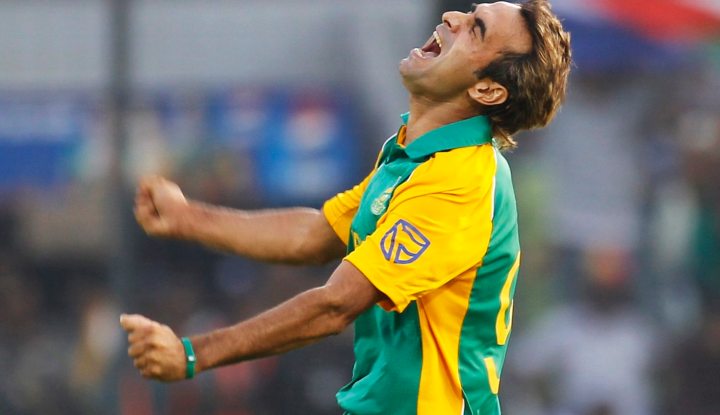Sport
Cricket: Five questions after South Africa’s ODI win against Pakistan

Pakistan managed a choke of such epic proportions that it would put South Africa to shame, as the visitors pulled off a heist and snuck a one-run win on Wednesday. A combination of the finest kind of ineptitude under pressure from Pakistan and some crafty bowling from the Proteas all combined for a nailbiting finish. ANTOINETTE MULLER picks five questions from the first ODI at Sharjah.
As if by some kind of magic force, South Africa stole a win from the jaws of defeat against Pakistan in the first of their five-match series on Monday. Despite a horror show of batting and Pakistan mostly cruising, the Proteas snuck a one-run victory over their hosts.
Impeccable bowling from Imran Tahir, Lonwabo Tsotsobe and Wayne Parnell in the latter part of the overs ensured South Africa clinched a thrilling win. Morne Morkel did the rest, leaving Mohammed Irfan to launch the Proteas into raptures of jubilation.
Pakistan lost five wickets for 12 runs in the space of just four overs. Until then, Pakistan looked in control, but South Africa’s bowling once again saved their skin. It was nothing short of a mercurial win, but that should not excuse the failures of the batsmen who have become unfairly reliant on their bowlers.
On Wednesday, not a single player in South Africa’s top four managed to pass 30. Out of their eleven, just two managed to cross that magical number, and one of them was a bowler.
The Proteas slumped to 183 all out, with only David Miller and Wayne Parnell managing scores of significance, as Saeed Ajmal’s wizardry was too much for the Proteas to cope with – the South African batsmen looked lost at sea again. Luckily for them, Pakistan did their best to engineer a rescue effort and with backup from South Africa’s bowlers, managed a choke to put the Proteas to shame.
There are questions aplenty after the win, but here are the top five.
What is the future of the top order?
Over the last few months, the top order has seen more combos than a chameleon sees colours on a Rubik’s cube. The inconsistency must be unsettling: with nobody at the top to set a foundation, the Proteas have often found themselves at sea. Graeme Smith is back now, but even he will need time to settle back in. Hashim Amla’s presence at the top of the order was certainly felt against Pakistan; he averages 55.30 opening and 57.06 in matches where he has opened with Graeme Smith. The two make a great combination, but that there is no backup is somewhat unsettling. A few have tried, but all of those have failed. Quinton de Kock doesn’t seem to have the faith of the selectors and doesn’t seem to have the capacity of international fire power just yet. Alviro Petersen was an experiment which came and went and Colin Ingram, for all his prowess in domestic cricket, continues to prove over and over again that perhaps he is just not cut out for the international stuff. When the pair of Smith and Amla are fit and available, things should settle down, but there isn’t really anybody else putting their hands up for the future.
Should the Proteas opt for a more stable middle order?
For the past few months, South Africa have experimenting with a “floating” middle order. It’s not like a floating shelf which is solid, reliable and knuckled down. Consistency is important and while a few players have proven they can adapt up and down the order, constantly fiddling with the line-up means there are no real defined roles. In T20 cricket, that makes sense. The game changes so quickly that all players have to be able to adapt. In one-day cricket, roles need to be more defined. Continuity means players know what is expected of them and while teams do need to be able to adapt to game plans, it’s better to look like you actually have a game plan instead of the current swings and roundabouts approach. David Miller works as a lower-order pinch hitter, JP Duminy works as a middle order cog in the wheel and Faf du Plessis, well, he doesn’t quite work at all, which brings us to the next point.
How many more chances for Faf du Plessis?
In the 43 games Faf du Plessis has played for South Africa, he’s scored six fifties and has only passed 70 once. He has similarly been moved up and down the order and has slotted in everywhere from three to seven. Since making his debut in 2011, Du Plessis has never averaged more than 30.00 in a year, though. That Du Plessis has future potential, there’s no doubt, but he has not made as much of an impact as many might have hoped. He’s another player who has been explosive on the domestic circuit but completely fizzed out when it comes to the international stuff. Parnell has been the form player on the domestic circuit and in just his first game in, he has proven that he can translate that form. Parnell is blossoming into a very handy all-rounder and perhaps it would benefit the Proteas to continue his evolution and consider Parnell for a dual role instead of sticking with Du Plessis.
Is AB de Villiers really captain material?
AB de Villiers is a very nice guy, but he is not a captain. Nice guys do not make good captains. Forget the fact that he still needs to learn how to manage over rates; as a man-manager, he’s just not quite up for the task. He used his bowlers far better in this match and deserves credit for sticking with Imran Tahir at the death, but one suspect that might very well be some of Smith’s influence doing the trick. In his 30 games as captain, De Villiers has led South Africa to victory just 15 times. Smith has featured alongside De Villiers in ten of his wins. In the games where SA have won, De Villiers averages a staggering 103.28. The dual role of keeping wicket and captaining a team clearly doesn’t have an impact on him all the time, but perhaps he isn’t quite cut out for the task of leading a team. De Villiers has scored five fifties and one hundred in the 17 games he played his year. He averages just 43.53, compared to his 107.50 in 13 games last year. Perhaps a needs a break – the problem is, there’s hardly anyone else who can commandeer the troops.
Should Jacques Kallis be playing?
Jacques Kallis has said that he wants to play in the 2015 World Cup. That’s still quite some time away, and for the cynical, he probably won’t be able to make that dream a reality. Kallis is being very carefully managed at the moment in order to ensure he can prolong his career for as long as possible. His bowling in Tests have been kept to reasonable levels and he has not played an ODI since February 2012. If he wants to be part of the ODI team, should he be in the side to prove that he still “has what it takes” or is it acceptable for Kallis to sit out, manage his body and keep things quiet until late next year to see whether he is up to the task? A tough question, which very few will want to answer. DM
Result summary:
South Africa 183 all out (49.5 overs)
David Miller 37 (51), Wayne Parnell 56 (70); Saeed Ajmal 10-2-30-4, Sohail Tanvir 9.5-1-33-2
Pakistan 182 all out (46.3 overs)
Ahmed Shehzad 58 (92), Misbah-ul-Haq 31 (49); Wayne Parnell 8-1-41-3, Imran Tahir 10-1-45-3
South Africa won by one run. DM
Photo: South Africa’s Imran Tahir celebrates taking the wicket of New Zealand’s Jesse Ryder during their Cricket World Cup quarter-final match in Dhaka March 25, 2011. REUTERS/Adnan Abidi




















 Become an Insider
Become an Insider